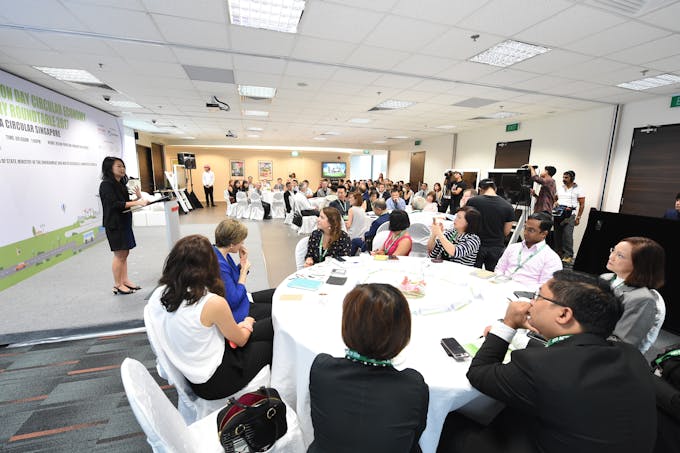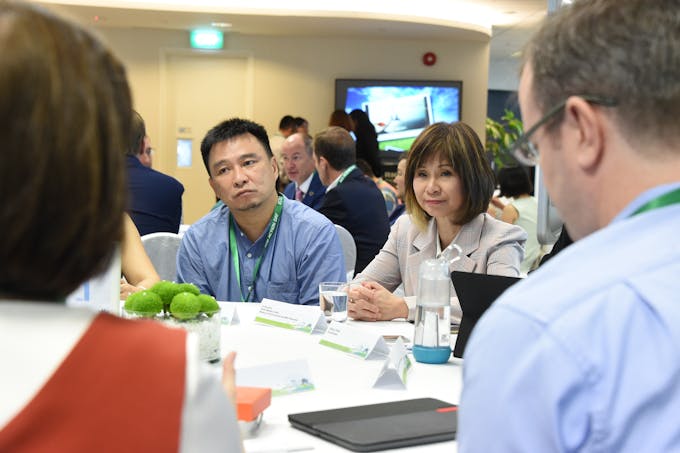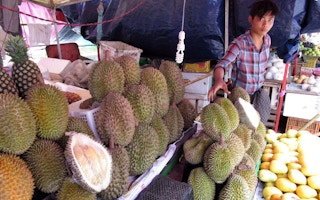When considering the circular economy, businesses should not only look at how to endlessly recycle products but also how to cut down the use of resources in the first place and designing for durability, said business leaders at a recent sustainability event in Singapore.
To continue reading, subscribe to Eco‑Business.
There's something for everyone. We offer a range of subscription plans.
- Access our stories and receive our Insights Weekly newsletter with the free EB Member plan.
- Unlock unlimited access to our content and archive with EB Circle.
- Publish your content with EB Premium.
“Circularity itself doesn’t necessarily need to be the goal,” said Jeff Turner, vice president of sustainability at nutrition company DSM, who pointed to Swedish fast fashion retailer H&M’s policy on ensuring that their clothes can be recycled.
“This is because they want to sell us even more garments. But look at the energy and water inputs. Cotton is incredibly water intensive both in terms of the initial processing and recycling,” he noted. Instead, Turner called on companies to make more durable products.

Eco-Business managing editor Jessica Cheam addresses delegates at Eco Action Day.
Consumers need to start thinking about using products for longer, added JD Kasamoto, general manager, service and environment division of printing firm Ricoh Asia Pacific.
“Goods today should be made more robust and more durable, so that there isn’t a need to recycle at all,” he said to the 50-strong audience of representatives from the government, private sector and civic society.
Both were speaking earlier this month at Eco Action Day, Ricoh’s annual environmental awareness event in commemoration of World Environment Day. This year’s event featured roundtable and panel discussions on how Singapore could transition towards a circular economy, and explored how each sector could contribute.
The government’s involvement was crucial because legislation could be an incentive for transformation—as seen in the example of Singapore’s water industry—and provide the stable and predictable market conditions that businesses prefer.
Senior minister of state for Environment and Water Resources and Health, Amy Khor, commented that legislation was neither a “panacea nor silver bullet”.
A circular economy is in line with the Sustainable Singapore Blueprint, a set of goals for the city-state to become more resource efficient and environmentally friendly by 2030, including the aim of eliminating waste, she said.
“Legislation has a part to play in setting and facilitating the right conditions and environment to motivate and nudge the development of circular economy practices among business and individuals,” said Khor.
However, echoing the views of others in the audience, Khor said that the shift towards more circular practices would require behavioural change from businesses. In order to reduce food waste, new hawker centres, communal food centres that are highly popular in Singapore, are required to have on-site food waste digesters, she gave as an example.
Khor shared that the extent to which the digesters are used depends on how convinced stallholders are that they should use them, and there are varying degrees of success across the different hawker centres. “The government is starting to see how we can faciltitate the process of behavioural change.”
Commenting that the messaging around sustainability tends to be quite lofty, Veerappan Swaminathan, director of think tank Sustainable Living Lab said that encouraging “incidental sustainability” would be a better approach.
“You don’t really need people to know that they are being sustainable, they just have to practice it,” he explained.
With specific reference to the possibility of a plastic bag fee to reduce plastic waste, he said that aligning consumer behaviour was really about finding out where they are emotionally invested, whether it is sustainability or saving money and “using that as leverage to change the game”.
Environmental groups in Singapore have long called for a mandatory plastic bag fee in order to discourage consumers from taking them unnecessarily, but retailers such as supermarket chain NTUC FairPrice have cited cost competitiveness as a reason against it.
There were also views that extended producer responsibility—that is, when producers are responsible for the disposal of their goods—could be an idea worth looking into further.
While Khor said the Singapore government has commissioned a study on this, Eugene Tay, executive director of anti-waste group Zero Waste SG, pointed out that it had been examining the possibility of this for the past decade.
Roundtable and panel discussion participants all agreed that the different sectors needed to cooperate to create a more circular economy. Ricoh’s Kasamoto said that Singapore could take a leaf from Japan’s experience with closed loop manufacturing where the government, consumer, manufacturer and retailer have to participate in disposing and recycling waste responsibly.
Japan is famous for its recycling and segregation practices. Consumers pay to have their belongings, such as computers and home appliances, removed and disposed of properly through waste management value chains, driven by both the public and private sectors.

Senior minister of state for Environment and Water Resources and Health, Amy Khor
The event, jointly organised by Ricoh Asia Pacific and Eco-Business, included the prize giving ceremony for the Eco Action Day Circular Economy Challenge, in which people between 17 and 30 years old were invited to come up with feasible market-based solutions for the circular economy
The top prize was awarded for an idea to collect and repurpose unwanted durian husks as packaging for durian sellers.
Team member Yeo Lik Khian, a PhD candidate under the Singapore-MIT Alliance for Research & Technology, said that the team realised through the challenge how central partnerships and thinking about the entire value chain are to the circular economy.
He said, “You have to think about everybody involved. You can’t just mind your own business.”










